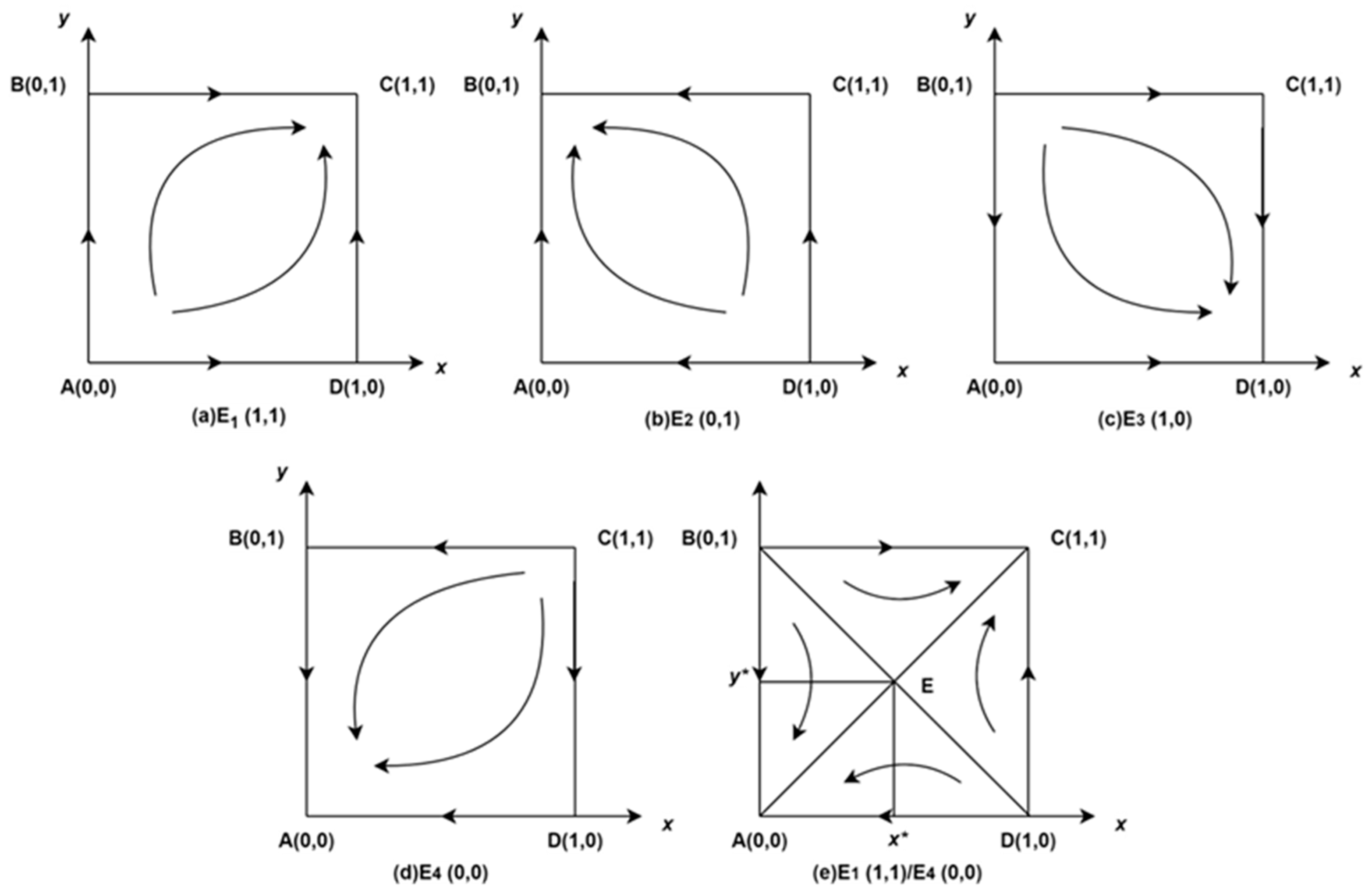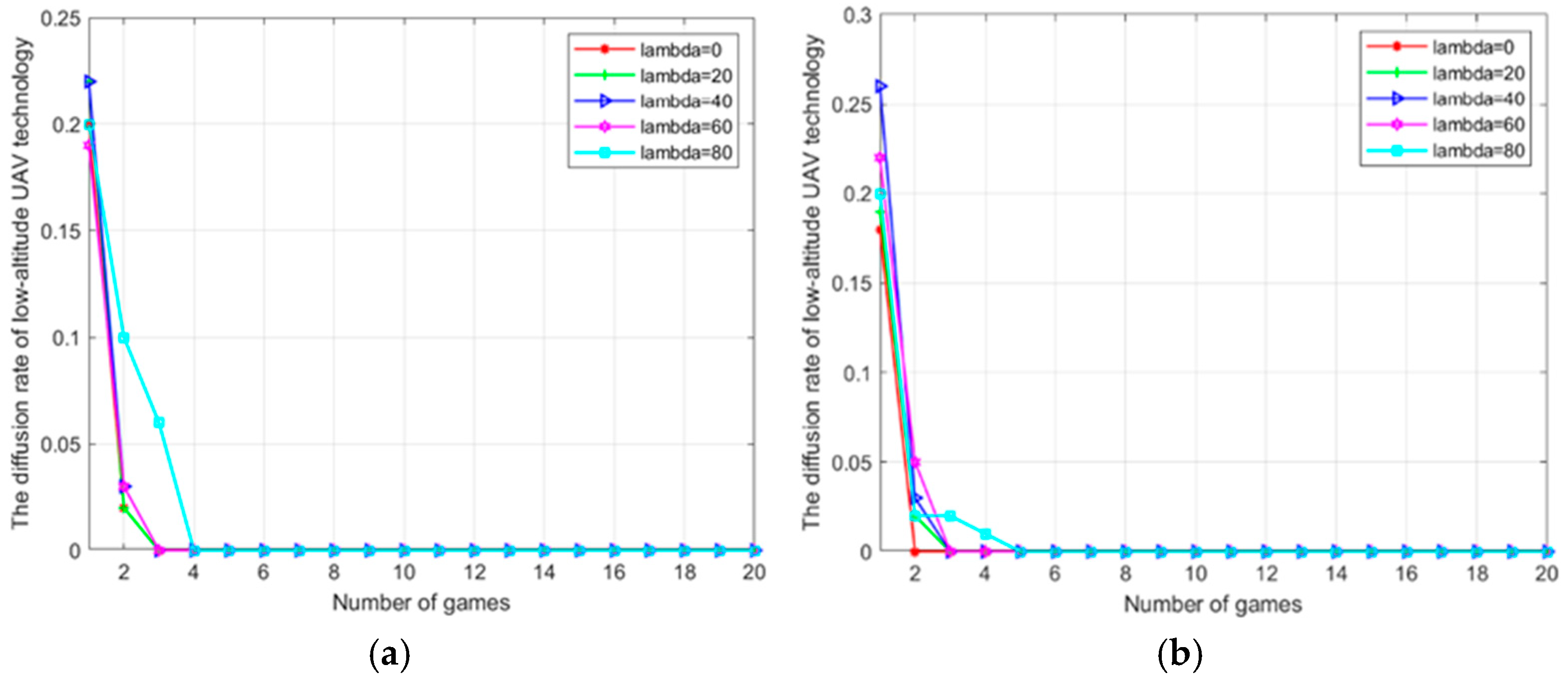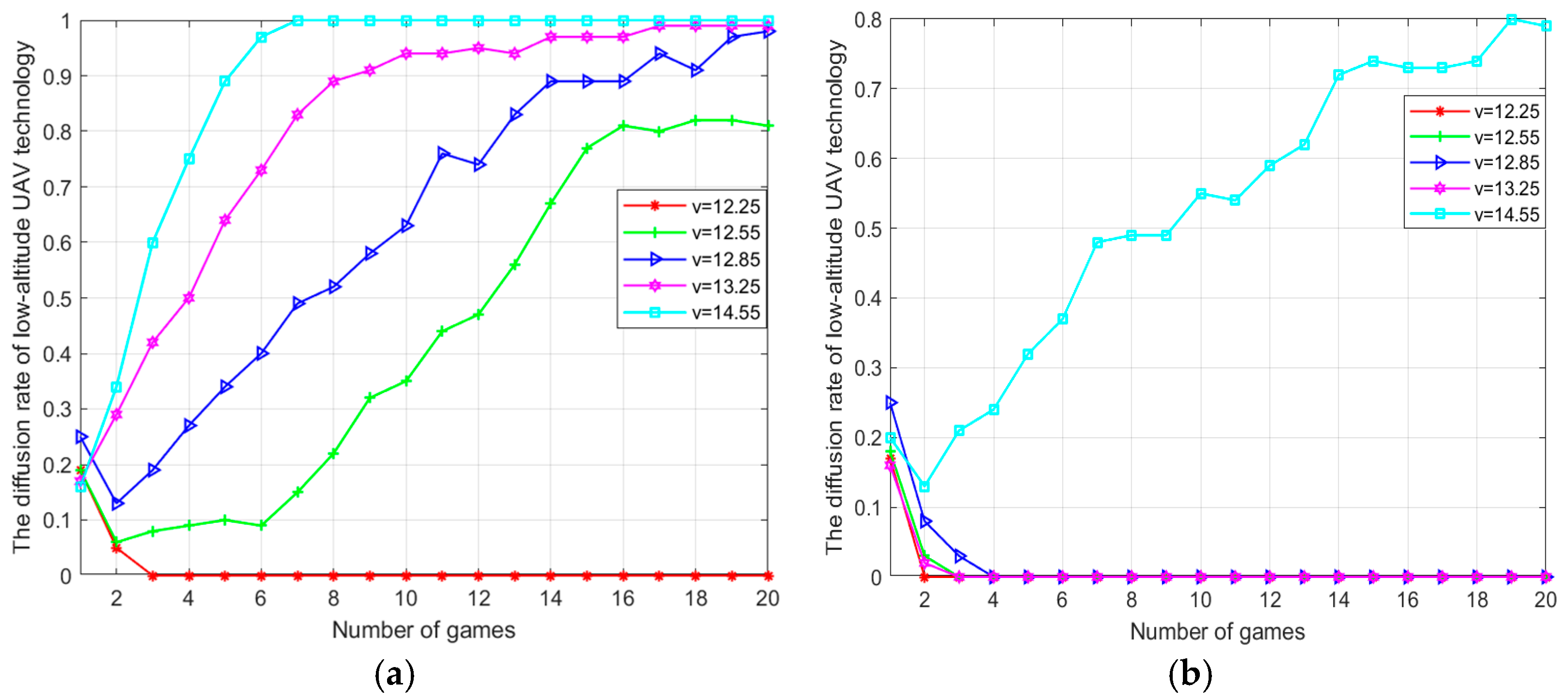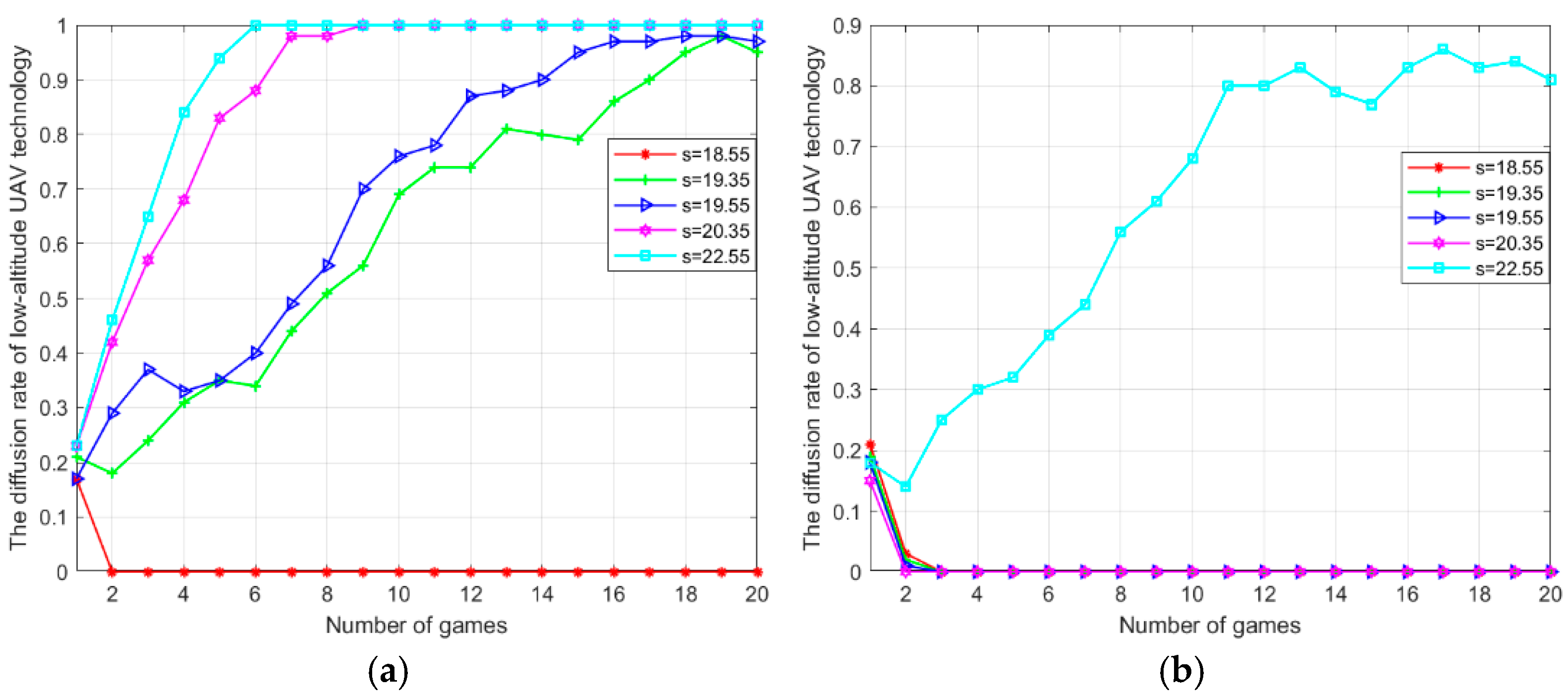Diffusion of Low-Altitude UAV Technology in Sustainable Development: An Evolutionary Game on Complex Networks
Abstract
1. Introduction
- (1)
- The complex network evolutionary game model is to be migrated to the study of low-altitude UAV diffusion.
- (2)
- Multiple factors affecting enterprise profit decision-making are to be comprehensively considered.
- (3)
- Traditional game theory analysis results are to be compared with complex network simulation results in order to verify the rationality of the model and parameter values.
2. Literature Review
2.1. Technology Diffusion Theory and Low-Attitude UAV Development
2.2. Complex Network Evolutionary Game
3. Game Model Construction
3.1. Model Assumptions
3.2. Enterprise Profits Under Government Intervention
- where:
3.3. Evolutionary Stability Analysis
4. Complex Network Model Construction
4.1. Construction of the Small-World Model
- (1)
- Generate a nearest-neighbor coupled network with nodes arranged in a ring, where each node is connected to its nearest neighbors ( is an even number). Randomly assign each enterprise an initial strategy based on the initial adoption proportion selected for the network.
- (2)
- With probability , randomly select a pair of nodes and add an edge between them. There is at most one edge between any two distinct nodes, and no node can connect to itself.
4.2. Strategy Update Rule
5. Numerical Simulation Analysis
5.1. Parameter Initialization Setting
5.2. Impact of Government Intervention on Low-Altitude UAV Technology Diffusion
5.3. Impact of Government Subsidies to Manufacturers on Low-Altitude UAV Technology Diffusion
5.4. Impact of Government Subsidies to Enterprises on Low-Altitude UAV Technology Diffusion
5.5. Impact of Constraint Penalty on Low-Altitude UAV Technology Diffusion
6. Conclusions and Implications
6.1. Research Conclusions
- (1)
- Addressing the core influencing factors: This study sought to identify the core factors influencing enterprises’ strategic choices. We conclude that these factors are threefold: (a) direct government subsidies to enterprises adopting the technology, which lower initial investment risks; (b) government subsidies to UAV manufacturers, which accelerate technological maturity and indirectly lower costs for adopters; and (c) the practical constraints on diffusion (e.g., airspace restrictions, safety risks, infrastructure shortcomings), which act as significant penalties and barriers to adoption.
- (2)
- Validating the efficacy and nuance of subsidy mechanisms: A primary objective was to empirically test the impact of government subsidies. We conclude that subsidy mechanisms are not merely beneficial but are essential for successful diffusion. Without them, diffusion fails. The simulation further reveals that diffusion rate increases with subsidy intensity and that the critical threshold for adoption is higher for Marginal Enterprises than for Core Enterprises, highlighting the need for differentiated policy.
- (3)
- Quantifying the impact of development constraints: This research aimed to integrate and quantify the tangible effects of real-world constraints. We conclude that constraints such as airspace issues and safety risks are pivotal negative factors. The diffusion rate decreases proportionally as the “penalty” from these constraints increases. When constraints are severe, they completely negate the positive effects of subsidies and lead to diffusion failure, underscoring the necessity of parallel regulatory and infrastructural policies.
6.2. Implications
- (1)
- This study makes significant contributions to social sustainable development at both theoretical and practical levels. Theoretically, it innovatively integrates complex network theory with evolutionary game theory to construct a dynamic model of low-altitude UAV technology diffusion, systematically revealing for the first time how government policies influence the diffusion process through networked interactions. The model captures the multiple sustainability benefits arising from the adoption of low-altitude UAV technology, including but not limited to reducing carbon emissions, enhancing agricultural productivity, and strengthening environmental monitoring capabilities. On the practical front, the research outcomes provide policymakers with a robust evidence-based foundation. Through comparative analysis within a unified framework, the study elucidates the relative effectiveness and sensitivity of different subsidy strategies (targeting manufacturers versus adopting enterprises), quantifies the impact of key constraints, and offers practical solutions for designing more effective policy instruments to accelerate the low-carbon transition driven by low-altitude UAV technology.
- (2)
- Based on the above conclusions, this paper proposes the following policy recommendations: Governments should establish targeted subsidy mechanisms, offering differentiated support—such as higher and longer subsidies for Marginal Enterprises—to overcome adoption barriers, while providing standardized incentives for Core Enterprises. Concurrently, subsidies should be directed to manufacturers to accelerate technological maturity and reduce costs. Furthermore, governments must actively mitigate constraints by accelerating the formulation of airspace and safety regulations, implementing integrated pilot programs in selected clusters to create demonstrable models for broader replication.
- (3)
- The findings offer clear guidance for key industry stakeholders: Enterprise managers should pursue first-mover advantages by aligning early adoption with government pilot programs and actively engaging in policy design. UAV manufacturers are advised to focus innovation on addressing core constraints—such as sense-and-avoid technology and noise reduction—to enhance product attractiveness. Meanwhile, industry consortia play a vital role in fostering collective action: disseminating best practices, establishing uniform standards, and promoting knowledge-sharing to reduce costs and risks, especially for marginal enterprises.
Author Contributions
Funding
Institutional Review Board Statement
Informed Consent Statement
Data Availability Statement
Conflicts of Interest
References
- Aydin, M.; Degirmenci, T.; Bozatli, O.; Radulescu, M.; Balsalobre-Lorente, D. Do green energy, command and control-based environmental regulations, and green growth catalysts for sustainable development? New evidence from China. J. Environ. Manag. 2025, 373, 123620. [Google Scholar] [CrossRef]
- Luo, J.; Xiao, F. Public Environmental Concerns, Green Technology Innovation and Corporate ESG Performance. J. Jiangxi Univ. Financ. Econ. 2025, 27, 1–15. [Google Scholar] [CrossRef]
- Lyu, R.; Li, Z.; Zhang, C. The role of energy performance contracting in green financial incentives and achieving SDGs: Environmental benefit or economic benefit. Ann. Oper. Res. 2025, 347, 1607–1641. [Google Scholar] [CrossRef]
- Li, Z.; Lyu, R.; Shi, V.; Chai, J. Optimal production strategies for manufacturer with renewable energy supply fluctuations and financial risk mitigation. Int. J. Prod. Res. 2025, 63, 1–21. [Google Scholar] [CrossRef]
- Tan, H.; Guo, Z.; Yan, J.; Zhang, D.; Chen, Y.; Zhang, H. Advancing low-carbon smart cities: Leveraging UAVs-enabled low-altitude economy principles and innovations. Renew. Sustain. Energy Rev. 2025, 222, 115942. [Google Scholar] [CrossRef]
- Semenov, S.; Krupska-Klimczak, M.; Mazurek, P.; Zhang, M.; Chernikh, O. Improving Unmanned Aerial Vehicle Security as a Factor in Sustainable Development of Smart City Infrastructure: Automatic Dependent Surveillance–Broadcast (ADS-B) Data Protection. Sustainability 2025, 17, 1553. [Google Scholar] [CrossRef]
- Dai, D.; Cai, H.; Wang, S. Optimization of a Cooperative Truck–Drone Delivery System in Rural China: A Sustainable Logistics Approach for Diverse Terrain Conditions. Sustainability 2025, 17, 6390. [Google Scholar] [CrossRef]
- Yanpirat, N.; Silva, D.F.; Smith, A.E. Sustainable last mile parcel delivery and return service using drones. Eng. Appl. Artif. Intell. 2023, 124, 106631. [Google Scholar] [CrossRef]
- Chouhan, S.S.; Patel, R.K.; Singh, U.P.; Tejani, G.G. Integrating drone in Agriculture: Addressing technology, challenges, solutions, and applications to drive economic growth. Remote Sens. Appl. Soc. Environ. 2025, 38, 101576. [Google Scholar] [CrossRef]
- Nafar, N.; Fatemi, M.; Rezaei-Moghaddam, K.; Ghafouri, M. From intention to action: A predictive model for drone adoption towards sustainability among Iranian farmers. Sustain. Futures 2025, 10, 101010. [Google Scholar] [CrossRef]
- Ogwu, M.C.; Kosoe, E.A. Integrating Green Infrastructure into Sustainable Agriculture to Enhance Soil Health, Biodiversity, and Microclimate Resilience. Sustainability 2025, 17, 3838. [Google Scholar] [CrossRef]
- Abdolazimi, O.; Duan, G.; Ma, J.; Wang, J. Integrated shipborne drone system for floating marine debris detection and management under oceanic environmental constraints. Comput. Ind. Eng. 2025, 207, 111264. [Google Scholar] [CrossRef]
- Karahan, A.; Gökçe, O.; Demircan, N.; Özgeriş, M.; Karahan, F. Integrating UAV Photogrammetry and GIS to Assess Terrace Landscapes in Mountainous Northeastern Türkiye for Sustainable Land Management. Sustainability 2025, 17, 5855. [Google Scholar] [CrossRef]
- Rani Hemamalini, R.; Vinodhini, R.; Shanthini, B.; Partheeban, P.; Charumathy, M.; Cornelius, K. Air quality monitoring and forecasting using smart drones and recurrent neural network for sustainable development in Chennai city. Sustain. Cities Soc. 2022, 85, 104077. [Google Scholar] [CrossRef]
- Xu, B.; Lai, F. Concurrent Improvement in Scale and Quality of China’s Low-Altitude Economy Industry: Connotation Analysis, Theoretical Logic, and Targeted Pathways. Dongyue Trib. 2025, 46, 121–129. [Google Scholar] [CrossRef]
- Wang, Z.; Yu, Z.; Bao, C.; Wang, Y.; Wang, K. Analysis of the Main Models and Paths for High-Quality Development of China’s Low-Altitude Economy. In Proceedings of the 3rd International Conference on Public Management, Digital Economy and Internet Technology, ICPDI 2024, Jinan, China, 6–8 September 2024. [Google Scholar]
- Guan, X.; Shi, H.; Xu, D.; Zhang, B.; Wei, J.; Chen, J. The exploration and practice of low-altitude airspace flight service and traffic management in China. Green Energy Intell. Transp. 2024, 3, 100149. [Google Scholar] [CrossRef]
- Liu, M.; Liu, S. Comparative Study on the Legal Supervision System of Low-Altitude Aircraft in China and Europe Based on Key Risks. In Proceedings of the 2nd International Conference on Green Aviation (ICGA 2024), Chengdu, China, 6–8 November 2024. [Google Scholar]
- Shen, Y.; Zhang, H. Impact of Digital Infrastructure Construction on the High-Quality Development of Low-Altitude Economy. J. Beijing Univ. Aeronaut. Astronaut. (Soc. Sci. Ed.) 2024, 37, 96–108. [Google Scholar] [CrossRef]
- Xu, C.; Liao, X.; Tan, J.; Ye, H.; Lu, H. Recent Research Progress of Unmanned Aerial Vehicle Regulation Policies and Technologies in Urban Low Altitude. IEEE Access 2020, 8, 74175–74194. [Google Scholar] [CrossRef]
- Wang, J.; Yang, Y. Role of Population Size and Quality in Technology Diffusion: Evidence from the OECD. J. Zhejiang Gongshang Univ. 2023, 37, 140–152. [Google Scholar] [CrossRef]
- Zhang, L.; Chen, C.; Chen, Z. Research on the Dual Mechanism of Technological Progress Affecting Technology Diffusion: A Perspective of Production Network. Shanghai J. Econ. 2021, 33, 88–101. [Google Scholar] [CrossRef]
- Schumpeter, J.A.; Swedberg, R. The Theory of Economic Development; Routledge: Oxfordshire, UK, 2021. [Google Scholar]
- Franceschinis, C.; Thiene, M.; Scarpa, R.; Rose, J.; Moretto, M.; Cavalli, R. Adoption of renewable heating systems: An empirical test of the diffusion of innovation theory. Energy 2017, 125, 313–326. [Google Scholar] [CrossRef]
- Pavitt, K. Sectoral patterns of technical change: Towards a taxonomy and a theory. Res. Policy 1984, 13, 343–373. [Google Scholar] [CrossRef]
- Schumpeter, J.A. Business cycles: A theoretical, historical and statistical analysis of the capitalist process. Rev. Econ. Stat. 1941, 23, 190–193. [Google Scholar] [CrossRef]
- Yang, Y.-c.; Liu, H.-t.; Liu, L.-b. An evolutionary game for analysis of implementation strategies in inter-regional diffusion of clean technology. Socio-Econ. Plan. Sci. 2024, 95, 102009. [Google Scholar] [CrossRef]
- Wang, X.C.; He, X.D.; Sun, X.Q.; Qin, M.C.; Pan, R.P.; Yang, Y.Y. The diffusion path of distributed photovoltaic power generation technology driven by individual behavior. Energy Rep. 2024, 11, 651–658. [Google Scholar] [CrossRef]
- Zhou, Y.; Yang, Q.; Lu, S. Research on the identification and formation mechanism of the main path of digital technology diffusion: Empirical evidence from China. Technol. Soc. 2023, 75, 102398. [Google Scholar] [CrossRef]
- Blaettchen, P.; Calmon, A.P.; Hall, G. Traceability Technology Adoption in Supply Chain Networks. Manag. Sci. 2025, 71, 83–102. [Google Scholar] [CrossRef]
- Pan, M.; Zhao, X.; Li, Z. Diffusion mechanism of green building in industrial clusters: An agent-based modeling approach. Dev. Built Environ. 2024, 19, 100504. [Google Scholar] [CrossRef]
- Guo, D. Classification Supervision and lts Legal Regulation of UAVs from the Perspective of Low-altitude Intelligent Networking. Jiang-Huai Trib. 2024, 326, 106–113. [Google Scholar] [CrossRef]
- Liao, H. Research on the UAV Regulatory Framework for the Low-Altitude Economy-Insights from U.S. Experience. China Bus. Mark. 2025, 39, 16–29. [Google Scholar] [CrossRef]
- Zhou, Y. Unmanned aerial vehicles based low-altitude economy with lifecycle techno-economic-environmental analysis for sustainable and smart cities. J. Clean. Prod. 2025, 499, 145050. [Google Scholar] [CrossRef]
- Ozbiltekin-Pala, M.; Yavas, V.; Ozkan-Ozen, Y.D. Drivers and barriers of unmanned aerial vehicles in emergency logistics operations. Technol. Soc. 2025, 82, 102894. [Google Scholar] [CrossRef]
- Vishal; Sharma, M.; Jain, S. Unmanned aerial vehicles and low-cost sensors for air quality monitoring: A comprehensive review of applications across diverse emission sources. Sustain. Cities Soc. 2025, 127, 106409. [Google Scholar] [CrossRef]
- Tavakol Sadrabadi, M.; Peiró, J.; Innocente, M.S.; Rein, G. Conceptual design of a wildfire emergency response system empowered by swarms of unmanned aerial vehicles. Int. J. Disaster Risk Reduct. 2025, 124, 105493. [Google Scholar] [CrossRef]
- Zhang, Z.; Xiao, C.-Y.; Zhang, Z.-G. Analysis and Empirical Study of Factors Influencing Urban Residents’ Acceptance of Routine Drone Deliveries. Sustainability 2023, 15, 13335. [Google Scholar] [CrossRef]
- Duan, W.; Li, C.; Zhang, P.; Chang, Q. Game modeling and policy research on the system dynamics-based tripartite evolution for government environmental regulation. Clust. Comput. 2016, 19, 2061–2074. [Google Scholar] [CrossRef]
- Hoppmann, J. Hand in hand to Nowhereland? How the resource dependence of research institutes influences their co-evolution with industry. Res. Policy 2021, 50, 104145. [Google Scholar] [CrossRef]
- Fan, R.; Wang, Y.; Chen, F.; Du, K.; Wang, Y. How do government policies affect the diffusion of green innovation among peer enterprises?—An evolutionary-game model in complex networks. J. Clean. Prod. 2022, 364, 132711. [Google Scholar] [CrossRef]
- Fan, R.; Bao, X.; Du, K.; Wang, Y.; Wang, Y. The effect of government policies and consumer green preferences on the R&D diffusion of new energy vehicles: A perspective of complex network games. Energy 2022, 254, 124316. [Google Scholar] [CrossRef]
- Li, J.; Jiao, J.; Tang, Y. An evolutionary analysis on the effect of government policies on electric vehicle diffusion in complex network. Energy Policy 2019, 129, 1–12. [Google Scholar] [CrossRef]
- Yang, Y.; Yang, S.; Yang, Y.; Yun, X.; Wang, Y. Study on Green Transformation Evolution of Construction Enterprises Based on Dissemination and Complex Network Game. Sustainability 2024, 16, 10130. [Google Scholar] [CrossRef]
- Li, Y.; Wu, J.; Wang, X.-P. Research on the Diffusion of Green Energy Technological Innovation from the Perspective of International Cooperation. Energies 2025, 18, 2816. [Google Scholar] [CrossRef]
- Pan, H.; Wang, Y.; Chen, Y.; Sun, J.; Liu, J. Network Evolutionary Game Analysis of Coal-to-Hydrogen CCUS Technology Dissemination in Carbon Trading Market. Sustainability 2025, 17, 418. [Google Scholar] [CrossRef]
- Zheng, S.; Zhang, J.; Jian, L. Green technology diffusion mechanism in China’s aviation industry cluster based on complex network game model. Energy 2024, 313, 133634. [Google Scholar] [CrossRef]
- Tang, X.; Lan, T.; Du, F.; Li, D.; Zhong, H.; Hu, Y.; Cai, B.; Li, H. Promoting data sharing diffusion in the automotive industry: An evolutionary game model on complex networks. Expert Syst. Appl. 2025, 286, 127992. [Google Scholar] [CrossRef]
- Barabási, A.-L.; Albert, R. Emergence of scaling in random networks. Science 1999, 286, 509–512. [Google Scholar] [CrossRef] [PubMed]
- Newman, M.E.J.; Watts, D.J. Renormalization group analysis of the small-world network model. Phys. Lett. A 1999, 263, 341–346. [Google Scholar] [CrossRef]
- Hu, Y.; Wang, Z.; Li, X. Impact of policies on electric vehicle diffusion: An evolutionary game of small world network analysis. J. Clean. Prod. 2020, 265, 121703. [Google Scholar] [CrossRef]
- Yang, S.; He, S. Policy Incentives for Digital Diffusion of Enterprises: Based on Complex Network Evolutionary Game Model. Soft Sci. 2023, 37, 8–16. [Google Scholar] [CrossRef]
- Su, Y.; Guo, W.; Zhang, A. Reverse transfer of tacit knowledge in M&A based on big data technology. Sci. Res. Manag. 2022, 43, 48–57. [Google Scholar] [CrossRef]
- Dong, J.; Zhang, X.; Liu, X. Research on Issues and Optimization Strategies in the Express Delivery Industry. Logist. Sci-Tech 2025, 48, 61–63. [Google Scholar] [CrossRef]
- Niu, B.; Zhang, J.; Xie, F. Drone logistics’ resilient development: Impacts of consumer choice, competition, and regulation. Transp. Res. Part A Policy Pract. 2024, 185, 104126. [Google Scholar] [CrossRef]
- Lu, F.; Jiang, R.; Bi, H.; Gao, Z. Routing Optimization of Drone Assisted Riders Takeout Delivery under Dynamic Orders. Chin. J. Manag. Sci. 2024, 32, 1–11. [Google Scholar] [CrossRef]





| Symbol | Meaning |
|---|---|
| Operating cost for enterprises using traditional technology | |
| Operating cost for enterprises using low-altitude UAV technology | |
| Penalty for low-altitude UAV diffusion constraints | |
| The number of enterprises in the network | |
| Price paid by consumers for traditional technology services | |
| Price paid by consumers for low-altitude technology services | |
| Total market demand | |
| Proportion of enterprises adopting low-altitude UAV technology in the cluster | |
| Subsidy given by the government to enterprises adopting low-altitude UAVs | |
| Government subsidy intensity for low-altitude UAV manufacturers | |
| Perceived value benefit of consumers for traditional technology | |
| Perceived value benefit of consumers for low-altitude UAV technology | |
| Consumer preference for low-altitude UAV technology | |
| Maturity of low-altitude UAV technology applications | |
| Initial maturity of low-altitude UAV technology applications | |
| The respective market shares of Core Enterprises and Marginal Enterprises when they adopt the same strategy | |
| Impact coefficient of government subsidies on the development level of low-altitude UAV technology | |
| The profits for Enterprises adopting low-altitude UAV technologies | |
| The profits for Enterprises adopting traditional technologies |
| Marginal Enterprise B | Core Enterprise A | |
|---|---|---|
| Low-Altitude UAV Technology | Traditional Technology | |
| Low-altitude UAV Technology | ; | ; |
| Traditional Technology | ; | ; |
| Equilibrium Points | ||
|---|---|---|
| ) | ) | |
| 0 |
| Condition | Equilibrium Points | Stability | ||
|---|---|---|---|---|
| + | − | ESS | ||
| − | * | Saddle Point | ||
| − | * | Saddle Point | ||
| + | + | Unstable Point | ||
| − | 0 | Non-Equilibrium Point | ||
| − | * | Saddle Point | ||
| + | − | ESS | ||
| + | + | Unstable Point | ||
| − | * | Saddle Point | ||
| − | 0 | Non-Equilibrium Point | ||
| − | * | Saddle Point | ||
| + | + | Unstable Point | ||
| + | − | ESS | ||
| − | * | Saddle Point | ||
| − | 0 | Non-Equilibrium Point | ||
| 0 | + | + | Unstable Point | |
| − | * | Saddle Point | ||
| − | * | Saddle Point | ||
| + | − | ESS | ||
| − | 0 | Non-Equilibrium Point | ||
| + | − | ESS | ||
| + | + | Unstable Point | ||
| + | + | Unstable Point | ||
| + | − | ESS | ||
| − | 0 | Non-Equilibrium Point |
| 100 | 4 | 0.2 | 0.4 | 0.4 | 20 | 200 | 0.6 | 0.4 | 24 | 10 | 15 | 12 | 3 | 0.6 | 0.4 | 0.1 |
Disclaimer/Publisher’s Note: The statements, opinions and data contained in all publications are solely those of the individual author(s) and contributor(s) and not of MDPI and/or the editor(s). MDPI and/or the editor(s) disclaim responsibility for any injury to people or property resulting from any ideas, methods, instructions or products referred to in the content. |
© 2025 by the authors. Licensee MDPI, Basel, Switzerland. This article is an open access article distributed under the terms and conditions of the Creative Commons Attribution (CC BY) license (https://creativecommons.org/licenses/by/4.0/).
Share and Cite
Liu, C.; Ma, J.; Ding, Y. Diffusion of Low-Altitude UAV Technology in Sustainable Development: An Evolutionary Game on Complex Networks. Sustainability 2025, 17, 8751. https://doi.org/10.3390/su17198751
Liu C, Ma J, Ding Y. Diffusion of Low-Altitude UAV Technology in Sustainable Development: An Evolutionary Game on Complex Networks. Sustainability. 2025; 17(19):8751. https://doi.org/10.3390/su17198751
Chicago/Turabian StyleLiu, Chang, Jiale Ma, and Yi Ding. 2025. "Diffusion of Low-Altitude UAV Technology in Sustainable Development: An Evolutionary Game on Complex Networks" Sustainability 17, no. 19: 8751. https://doi.org/10.3390/su17198751
APA StyleLiu, C., Ma, J., & Ding, Y. (2025). Diffusion of Low-Altitude UAV Technology in Sustainable Development: An Evolutionary Game on Complex Networks. Sustainability, 17(19), 8751. https://doi.org/10.3390/su17198751






